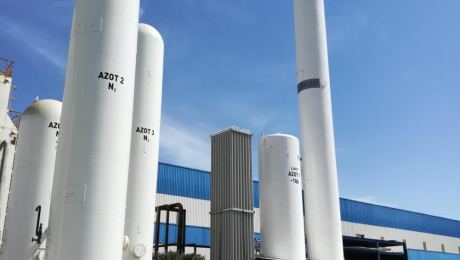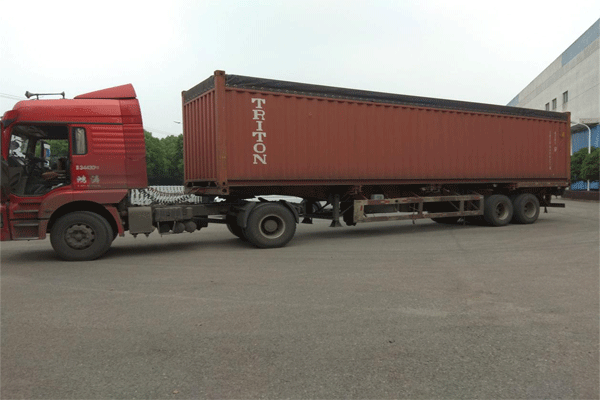Pressure vessel
Wednesday, 13 June 2018
Because the air separation plant is always involved in pressure vessel issue, so the pressure vessel is also one part of air separation plant. The first article : in order to make sure the safe operation of the pressure vessel and protect the safety of people’s lives and property and to promote the development of national economy, this code is formulated according to the relevant provisions of the Interim Regulations on safety supervision of boilers and pressure vessels. The second article: The applicable scope of this procedure is as follows; This procedure is applicable to pressure vessels with the following conditions Maximum working pressure (Pw) (note 1) greater than 0.1MPA (no hydrostatic pressure, same below) Inner diameter (non-circular section refers
Turkey plant is being commissioning
Friday, 08 June 2018
The air separation plant sold by our company to Turkish customers has been successfully installed. Now the equipment is being commissioned.
Italian nitrogen production equipment shipped at the end of May
Monday, 04 June 2018
The nitrogen plant sell to our Italy client is successfully delivered in this month; The unattended nitrogen plant supplied by Suzhou Xinglu Air Separation Plant Science and Technology Development Co.,Ltd can apply for many purpose, such as use the nitrogen as protection air, material air, purging air and sealing air etc.
The rapid development of China’s air separation industry
Thursday, 31 May 2018
In terms of the development of large-scale air separation plants in China, the number of large-scale air separations has reached an absolute majority in the world. The ratio of 60,000-class air separations to global air separation is greater than 75 percent; the domestic monomer scale has reached 100,000-scale. In the market demand of the past three years, the proportion of extra-large air separations accounted for the vast majority. The characteristics of the construction of air separation plants in China in recent years are as follows: First, attach importance to the stability of equipment units, because it limited by the conditions of transportation and installation is difficult. Second, the equipment installation time is short, there are loopholes in management. Three, Some
The kinds of the adsorbents
Tuesday, 22 May 2018
The adsorbents usually used in the industry include: the Silica gel ,active alumina, activate carbon molecular sieve and etc. Moreover, there are also other adsorption material as per some composition selective adsorption, whether the air can be successfully adsorbed, it is mainly depended on the adsorption performance, so the adsorbent selection is the first issue for the adsorption confirm. Active aluminium oxide is made from the Aluminum hydrates are heated and dehydrated. Its performance is depended on the preliminary state form the hydroxide, it is usually not the pure Al2O3,Partially hydrated amorphous porous structural material.In which there are not only amorphous gels but also crystals of hydroxide.It has strong affinity for water and is an adsorbent for deep drying of
The role of air separation equipment in the industrial field and the big secrets for the demand
Friday, 18 May 2018
With the rapid development of China’s economy, the importance and role of industrial gases in the economy have become increasingly prominent. As an important basic raw material for modern industry, gas products have a wide range of applications. Industrial gases mainly include oxygen, nitrogen, argon, helium, neon, krypton, xenon, hydrogen, carbon dioxide, acetylene, natural gas, etc., involving all aspects of industry. The industrial gases mentioned in this paper mainly refer to the ability to separate and obtain oxygen, nitrogen, and argon through air filtration equipment. Rare gases such as helium and neon can also be obtained by further purification. Preparation of oxygen, nitrogen, and argon is mainly achieved through air separation equipment. Large-scale air separation equipment is mainly used in
The separation of inert gases in the air
Wednesday, 02 May 2018
Would you like to know how to manufacture the industrial rare gas? Although the industrial gas is usually the nitrogen, but it not as rare gas. Nitrogen is air separated, rectified from the air cryogenic liquefied, then the nitrogen and oxygen can be got etc. Helium is mainly from the natural gas, because its content in the air is too little, some mineral resources of the natural gas contain much Helium. It can be air separated by liquefaction, Helium is one kind of rare resources, it is really little in the earth, it is basically non-renewable resources, the price is increasing recent years. Certainly, Helium is also got form the air separation, because Helium and neon are really difficult to
Italy Customer visiting and investing plant on site
Monday, 23 April 2018
From March 19th to March 24th in 2018, The Italy Italy Customer came to visist XLA. During this trip, They visited Yi chuan &Xishui Plant site in China. They spoke highly for the two plants。They visited the workshop in XLA. They approve the air separation plant of XLA. They considered the technology from design to manufacturing of air separation plant by XLA is vey mature and XLA also accumulated a lot of experience in this industry, which will get a higher level in the air separation industry.
How much do you know about the air separation unit operation control system?
Sunday, 08 April 2018
The air separation unit adopts cryogenic technology, which uses oxygen and nitrogen gas to separate gas at different boiling point under the same pressure to extract oxygen, nitrogen and other gas components in the air. At present, the main air separation processes are divided into internal compression processes and external compression processes. Most of the newly designed air separation units use the DCS control system. The DCS control system better realizes the chain protection and anti-surge control of air compressors, the sequence control of molecular sieve systems, and other conventional controls. The implementation of the DCS system has smoothed the operation of the equipment to some extent, and improved the control level of the equipment. In order to achieve automatic variable
The definition of LNG
Sunday, 08 April 2018
The definition of LNG Liquid natural gas (LNG) is natural gas (predominantly methane, CH4, with some mixture of ethane C2H6) that has been converted to liquid form for ease and safety of non-pressurized storage or transport. It takes up about 1/600th the volume of natural gas in the gaseous state (at standard conditions for temperature and pressure). It is odorless, colorless, non-toxic and non-corrosive. Hazards include flammability after vaporization into a gaseous state, freezing and asphyxia. The liquefaction process involves removal of certain components, such as dust, acid gases, helium, water, and heavy hydrocarbons, which could cause difficulty downstream. The natural gas is then condensed into a liquid at close to atmospheric pressure by cooling it to approximately −162 °C



